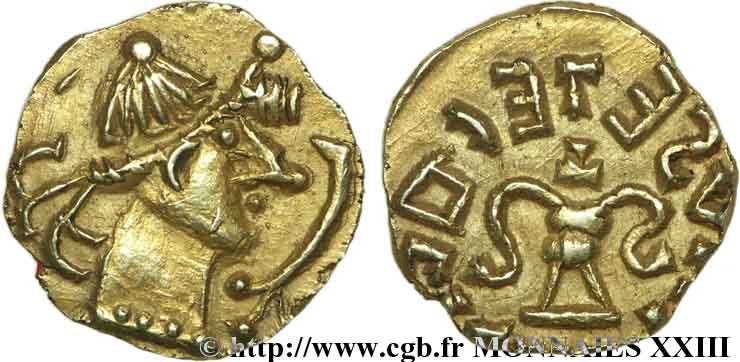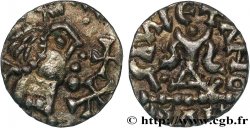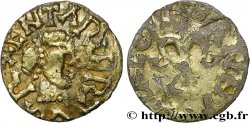v23_0916 - MEROVINGIAN COINAGE - BANASSAC (BANNACIACO) - Lozere Triens, monétaire ELAFIVS
MONNAIES 23 (2004)
Starting price : 2 000.00 €
Estimate : 3 500.00 €
Realised price : 4 000.00 €
Number of bids : 9
Maximum bid : 4 000.00 €
Starting price : 2 000.00 €
Estimate : 3 500.00 €
Realised price : 4 000.00 €
Number of bids : 9
Maximum bid : 4 000.00 €
Type : Triens, monétaire ELAFIVS
Date: (VIIe siècle)
Mint name / Town : Banassac
Metal : gold
Diameter : 12 mm
Orientation dies : 9 h.
Weight : 1,09 g.
Rarity : R3
Coments on the condition:
Belle monnaie, avec une frappe vigoureuse. Droit particulièrement bien centré, mais revers sur flan court
Catalogue references :
Predigree :
Cet exemplaire aurait été acheté en avril 1941. Il provient de la collection Ponton d’Amécourt
Obverse
Obverse legend : ANÉPIGRAPHE.
Obverse description : Tête barbare diadémée, à droite ; diadème très saillant à la tranche perlée ; calotte et bouton occipital ; devant le profil, rameau renversé à trois baies.
Reverse
Reverse legend : [...]VS ET EIAC[...] RÉTROGRADE.
Reverse description : Calice à deux anses, supportant un T renversé.
Commentary
Ce triens est celui qui illustre le Belfort, n° 668. La plupart des autres exemplaires ont la légende ELAFIVS MONETA. Le sens de notre légende de revers ne semble pas avoir été compris.
La description du Belfort donne la légende décomposée en ...VS ET EIAT... ; il pourrait s’agir d’une association de deux monétaires, dont ELAFIVS ? Dans la série de triens du Belfort, seul celui-ci a la légende du revers rétrograde. Si seules les lettres étaient rétrogrades, et non le sens de lecture, la légende ...CALETESV... pourrait laisser un doute sur l’attribution au monétaire ELAFIVS. Certains triens avec le nom de monétaire au revers ont la légende BAN à l’exergue, pour BANASSAC.
La description du Belfort donne la légende décomposée en ...VS ET EIAT... ; il pourrait s’agir d’une association de deux monétaires, dont ELAFIVS ? Dans la série de triens du Belfort, seul celui-ci a la légende du revers rétrograde. Si seules les lettres étaient rétrogrades, et non le sens de lecture, la légende ...CALETESV... pourrait laisser un doute sur l’attribution au monétaire ELAFIVS. Certains triens avec le nom de monétaire au revers ont la légende BAN à l’exergue, pour BANASSAC.








 Report a mistake
Report a mistake Print the page
Print the page Share my selection
Share my selection Ask a question
Ask a question Consign / sell
Consign / sell
 Full data
Full data